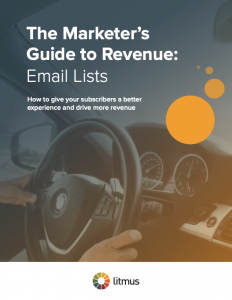Not sure how to develop a long-term strategy for managing your inactive email subscribers? While it’s tempting to boil down inactive strategies to a single operating principle, a more targeted strategy is more effective.
The question isn’t whether inactive subscribers have value. As a group, they certainly do. Instead, the questions to ask are:
- Which inactive subscribers are the most valuable and least risky to the business?
- And conversely, which are the most risky and least valuable to the business?
- At what point do the deliverability risks associated with inactive subscribers outweigh the value they generate?
To answer these questions, we must look at the type of inactive subscriber as well as the context of your brand. Let’s explore all of that.
What’s an inactive subscriber?
An inactive subscriber is someone on your email list who hasn’t engaged with any of your emails after a set amount of time. Engagement is usually defined by an open or click but can depend on your particular email marketing program. The same can be said about what amount of time after non-engagement is best before calling a subscriber inactive.
Some recommendations are below based on the type of inactive email subscriber.
The different inactive email subscribers
Now, let’s talk about the context of your inactive subscribers. They don’t all fall in the same spot along the risk-value spectrum.

There are three major kinds of inactives: never-actives, lapsed customer inactives, and current customer inactives.
1. Never-actives
First are subscribers who have never engaged with your emails from the moment they signed up. Your tolerance for these inactives should be very low, as their lack of engagement is a signal you don’t have a healthy relationship. It could be because they:
- Didn’t realize they opted in, which might be the result of poor permissioning practices
- Subscribed using a secondary or tertiary email account they don’t check often, if at all
- Have subscriber’s remorse and immediately regretted subscribing
- Could be the result of bot activity if you’re using email signups for sweepstakes or other contest entries
- Were signed up maliciously—that is, someone other than the email address holder signed up the address
The risks associated with these subscribers are high while the potential value is low. When not using a confirmed opt-in process, marketers should strongly consider using engagement post-signup as confirmation of a subscription.
The cutoff mark may vary depending on your email frequency, but if a subscriber hasn’t opened or clicked any of the emails during their first four months on your list or any of the first 10 emails you’ve sent them (whichever comes first), then that should likely trigger a re-permission email that requires them to click a link in the email to confirm they want to continue receiving emails.
One caveat: If you’re seeing a substantial number of never-actives, especially on a single email client like Gmail, then it might be a sign your emails are being sent to the junk folder. Since few people check their spam folder on a regular basis, your emails could be completely unseen.
 |
Make it to the inbox, not the spam folder Identify issues that might keep you from the inbox and get actionable insights for how to fix them with Litmus Spam Testing. |
2. Lapsed customer inactives
The second type of inactive subscribers are those who are also inactive customers. Not only have they stopped opening and clicking your emails, but there’s also no evidence they’re buying, donating, or otherwise converting.
The risks associated with these inactives are moderate and the potential value is moderate, since they have engaged—and hopefully even purchased—in the past. For that reason, you want to give these inactives a reasonable opportunity to re-engage.
While six months of inactivity is sometimes cited as a good trigger, it may feel pretty aggressive or too lax depending on how frequently your average subscriber gets an email from you.
If you send emails one or more times a day, waiting six months may be too long. For lower frequency senders that send less than once a week, a longer timeframe may be better. For example, brands with a lot of customers who only buy during the holidays or supporters who only donate at the end of the year may want to look at 13 months of inactivity to accommodate this once-a-year seasonal behavior.
Whether you use 6, 13, or any other number of months of inactivity as your threshold, that should trigger effective re-engagement emails followed by last-ditch re-permissioning efforts that ask inactives to confirm they want to continue receiving your emails. It’s only if all of those efforts fail that you purge these subscribers from your active mailing list and add them to a suppression list.
 |
Healthy email list. Healthy ROI. Subscribers fuel your overall email program success. Learn how to get more good subscribers. And more revenue. |
3. Current customer inactives
And third are the inactive subscribers who are still actively buying from you. The risks associated with these inactives are low while the potential value is high. Given that many of these subscribers may be influenced by your emails without engaging, it may make sense for you to keep these inactives for years.
With current customer inactives, you not only need to define what an inactive subscriber is but also need to define an inactive customer. When doing so, keep your product and purchase lifecycles in mind. For instance, the purchase cycles for a car brand, tablet computer brand, and bookstore brand will be incredibly different.
How you treat your lapsed customer inactives and current customer inactives depends heavily on…
Your brand’s context
Not every brand can afford to react to those three groups of inactives in the same way. Some will have a much greater tolerance for deliverability risk while others will have much lower tolerances. Ask yourself:
- Does your organization have strong permission practices? Are all or most of your email addresses confirmed via a double opt-in process or validation tool?
- What percentage of your active mailing list has engaged in the past month? 3 months? 6 months?
- Does your brand have good visibility into your deliverability? If there was a problem, how quickly would you realize it?
- Are you able to match up customer activity with subscriber activity?
- Would you know how to solve a deliverability problem if you had one? Do you work with or have access to a deliverability specialist?
- Have you had deliverability issues in the past? How much did those incidents hurt your business?
Depending how you answer those questions, your appetite for deliverability risk will be different.
For instance, if you’ve suffered painful deliverability issues recently, you might start addressing your lapsed customer inactives sooner than your current customer inactives to prevent getting burned again since inbox providers will keep a closer eye on you after having already flagged your brand once. And if your list has very low engagement, then you’ll need to be more aggressive at addressing inactivity.
Whereas if you have great engagement and deliverability, and you have resources on hand to address problems, you might start addressing lapsed customer inactives at 13 months and current customer inactives at 37 months.
Don’t have enough of a single view of the customer to tell which inactives are current customers? Then you have to have the same threshold for current customer inactives as you do for your lapsed customer inactives, since you won’t be able to tell the two groups apart.
Keep inactive emails in check
There’s no “one size fits all” answer for how to manage inactives. Every brand needs to determine their own risk tolerance. Then, put in place an on-going process for how and when to deal with each of the three kinds of inactive subscribers to maximize success and keep the risks in check.
Originally published on March 17, 2016, by Chad S. White. Last updated July 14, 2021.
The post What You Need to Know to Manage the 3 Kinds of Inactive Email Subscribers appeared first on Litmus.
![]()

